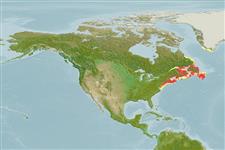Environment: milieu / climate zone / depth range / distribution range
Ökologie
seewasser; brackwasser demersal; tiefenbereich 0 - 73 m (Ref. 57178). Temperate; 62°N - 35°N, 82°W - 3°W (Ref. 57356)
Northwest Atlantic: southern Delaware north to Labrador.
Length at first maturity / Size / Gewicht / Alter
Maturity: Lm 9.0, range 7 - ? cm
Max length : 23.5 cm TL Männchen/unbestimmt; (Ref. 5951)
Kurzbeschreibung
Morphologie | Morphometrie
Rückenflossenstacheln (insgesamt): 0; Rückenflossenweichstrahlen (insgesamt): 52-61; Afterflossenstacheln 0; Afterflossenweichstrahlen: 26 - 33; Wirbelzahl: 62 - 70. Number of lateral plicae 106-126, with a mean of 117.4. Best separated from A. dubius by the number of plicae singly or in combination with the number of vertebrae.
Found in shallow coastal waters as well as in protected bays and estuaries (Ref. 10198). Occurs in large schools and burrows in the sand at times to a depth of several inches. Feeds primarily on copepods (Ref. 27549).
Nizinski, M.S., B.B. Collette and B.B. Washington, 1990. Separation of two species of sand lances, Ammodytes americanus and A. dubius, in the western North Atlantic. Fish. Bull. 88:241-255. (Ref. 10198)
IUCN Rote Liste Status (Ref. 130435)
Bedrohung für Menschen
Harmless
Nutzung durch Menschen
Fischereien: kommerzielles potential
Mehr Information
ReferenzenAquakulturAquakultur ProfilZuchtlinienGenetikElectrophoresesVererbbarkeitKrankheitenVerarbeitungNutrientsMass conversion
PartnerBilderStamps, Coins Misc.LauteCiguateraGeschwindigkeitSchwimmstilKiemenoberflächeOtolithsGehirngrößeSehfähigkeit
Tools
Zusatzinformationen
Download XML
Internet Quellen
Estimates based on models
Preferred temperature (Ref.
123201): 2.7 - 14.2, mean 7.9 °C (based on 128 cells).
Phylogenetic diversity index (Ref.
82804): PD
50 = 0.5156 [Uniqueness, from 0.5 = low to 2.0 = high].
Bayesian length-weight: a=0.00204 (0.00128 - 0.00325), b=3.16 (3.03 - 3.29), in cm total length, based on LWR estimates for this species & Genus-body shape (Ref.
93245).
Trophic level (Ref.
69278): 3.2 ±0.0 se; based on diet studies.
Generation time: 4.6 ( na - na) years. Estimated as median ln(3)/K based on 1
growth studies.
Widerstandsfähigkeit (Ref.
120179): mittel, Verdopplung der Population dauert 1,4 - 4,4 Jahre. (Preliminary K or Fecundity.).
Fishing Vulnerability (Ref.
59153): Moderate vulnerability (37 of 100).
Nutrients (Ref.
124155): Calcium = 60.3 [31.5, 129.4] mg/100g; Iron = 0.414 [0.224, 0.729] mg/100g; Protein = 19 [18, 20] %; Omega3 = 0.421 [0.214, 0.762] g/100g; Selenium = 10.4 [4.7, 22.7] μg/100g; VitaminA = 30.5 [10.1, 92.3] μg/100g; Zinc = 0.845 [0.569, 1.247] mg/100g (wet weight);
